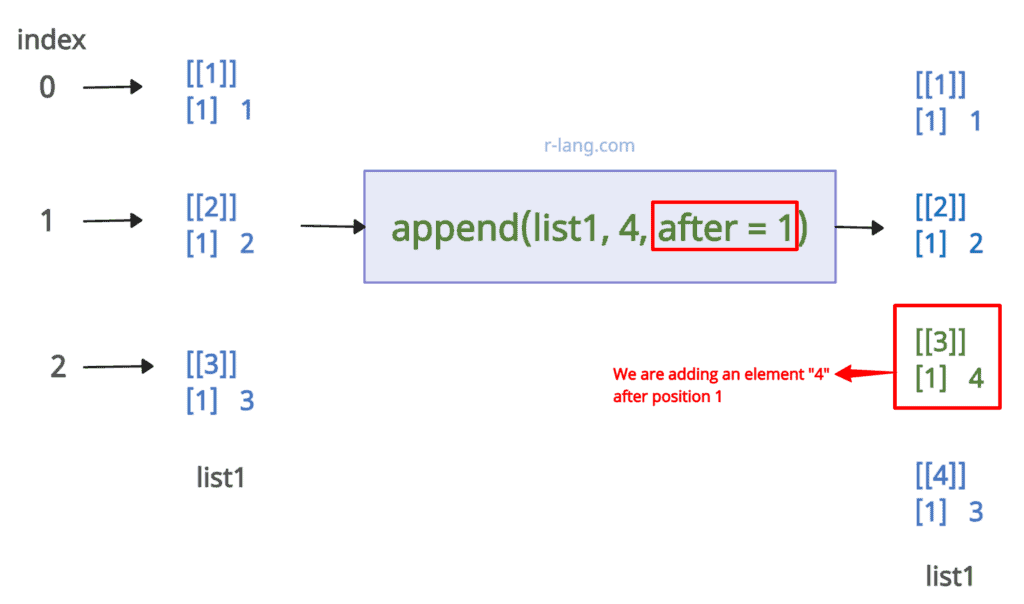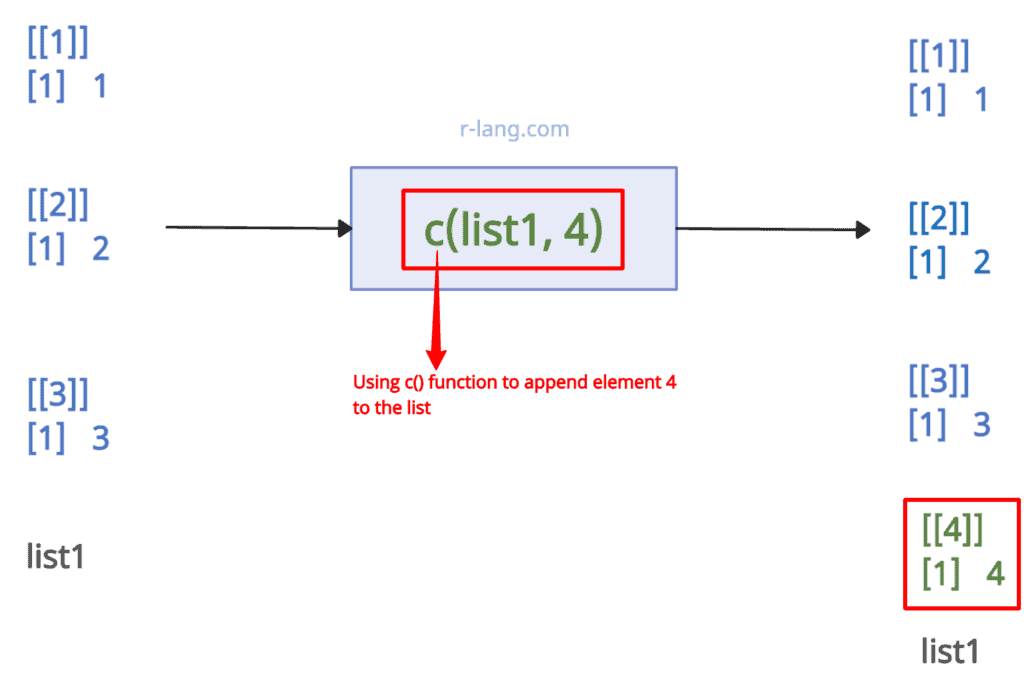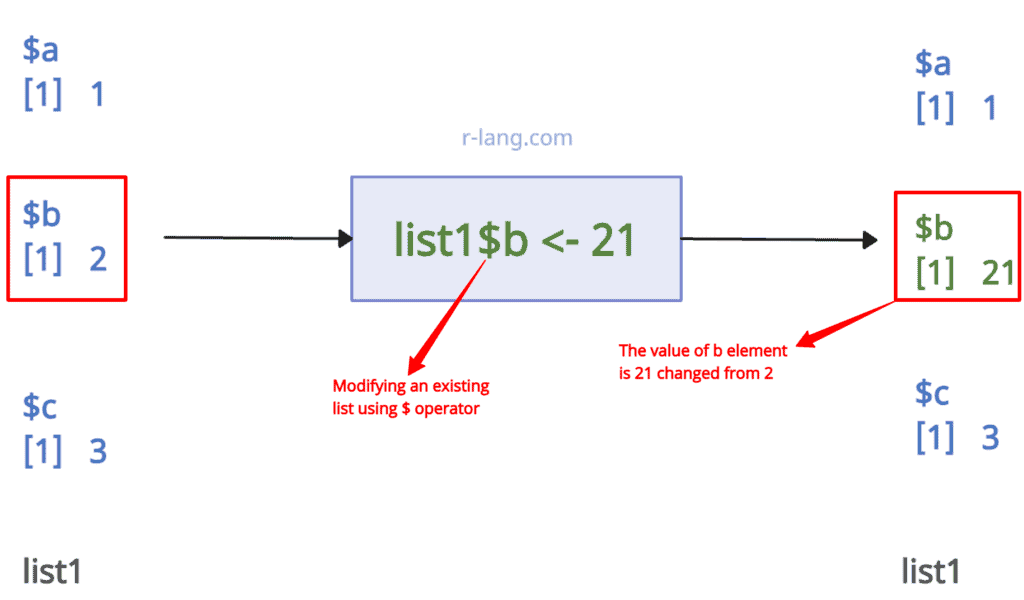When you don’t know the size of your data, you can use the “list” data structure as you can grow or shrink based on your requirements. In many data operations, we build up results piece by piece, appending them to a list as we go.
To grow the list, you can add an element (numeric value, character vectors, other lists, data frames, or functions) at whichever position you like.
Here are five ways to add an element to a list at any position in R:
- Using append()
- Using c()
- Using the rlist library
- Using $ operator
- Using the double bracket ( [[ )
Method 1: Using append()
If you are picky about which position you want to add an element, append() is the method for you. It lets you add an element at the end of the list but provides an argument “after” through which you can add an element anywhere.
It is like a magic wand in your hand that lets you place your new element exactly where you want it in the list.
Example 1: Adding an element at the end of the list

list1 <- list(a = 1, b = 2, c = 3)
list2 <- list(d = 4)
appended_list <- append(list1, list2)
print(appended_list)Output
$a
[1] 1
$b
[1] 2
$c
[1] 3
$d
[1] 4Example 2: Appending an element at the specific position
Here, we added an element (4) after the position 1 using the “after” parameter.
list1 <- list(1, 2, 3)
list2 <- append(list1, 4, after = 1)
print(list2)Output
[[1]]
[1] 1
[[2]]
[1] 2
[[3]]
[1] 4
[[4]]
[1] 3With after = 1, you are explicitly telling R to put the new element right after the first item.
Example 3: Appending multiple elements
The above figure shows that we added 3 elements (4, 5, 6) at the end of the list.
list1 <- list(1, 2, 3)
elements <- c(4, 5, 6)
multi_list <- append(list1, elements)
print(multi_list)
Output
[[1]]
[1] 1
[[2]]
[1] 2
[[3]]
[1] 3
[[4]]
[1] 4
[[5]]
[1] 5
[[6]]
[1] 6Time complexity: O(n), where n is the number of elements in the list.
Space complexity: O(n), as it creates a new list.
Method 2: Using c()
To simultaneously add single or multiple elements to a list, use the c() function. This approach is straightforward but not the most efficient for large lists due to R’s copy-on-modify semantics.
The above figure shows that we appended element 4 at the end of the position.
list1 <- list(1, 2, 3)
list1 <- c(list1, 4)
print(list1)
Output
[[1]]
[1] 1
[[2]]
[1] 2
[[3]]
[1] 3
[[4]]
[1] 4You can use this approach when you need fine-grained control over the insertion position.
Time complexity: O(n), where n is the number of elements in the list.
Space complexity: O(n), as it creates a new list.
Method 3: Using the ‘rlist’ library
The above figure shows that we used the rlist library’s list.append() function to add an element (4) at the end of the list highlighted by the red marker.
For this practical, you need to install the “rlist” library. Use the below command to install it.
install.packages("rlist")library("rlist")
list1 <- list(a = 1, b = 2, c = 3)
new_list <- list.append(list1, d = 4)
print(new_list)Output
$a
[1] 1
$b
[1] 2
$c
[1] 3
$d
[1] 4Method 4: Using $ operator
The $ operator is not typically used for adding new elements but can be used for modification. However, if the name provided after the $ does not exist in the list, it will add a new element with that name.
Example 1: Adding a new element
list1 <- list(a = 1, b = 2, c = 3)
list1$d <- 4
list1Output
$a
[1] 1
$b
[1] 2
$c
[1] 3
$d
[1] 4This approach is still unsuitable for adding new elements instead, you can use the $ operator to modify existing list elements.
Example 2: Modifying an existing element
It modifies the list in place and is efficient for appending to the end. However, it needs careful management of indices.
In the above figure, we modified a list by updating element “b” to 21.
list1 <- list(a = 1, b = 2, c = 3)
list1$b <- 21
cat("After modifying the list", "\n")
print(list1)
Output
After modifying the list
$a
[1] 1
$b
[1] 21
$c
[1] 3Time complexity: O(1) for appending to the end, O(n) for inserting in the middle.
Space complexity: O(1), as it modifies the existing list.
Method 5: Using the double bracket [[
The double bracket ([[) approach is more direct than the c() function and avoids some copying overhead, which is especially helpful in any type of loop.
Example
list1 <- list(1, 2, 3)
list1[[length(list1) + 1]] <- 4
cat("After adding an element the list", "\n")
print(list1)
Output
After adding an element the list
[[1]]
[1] 1
[[2]]
[1] 2
[[3]]
[1] 3
[[4]]
[1] 4The output shows that the element “4” is added at the end of the list.
Time complexity: O(1) for appending to the end, O(n) for inserting in the middle.
Space complexity: O(1), as it modifies the existing list.

Krunal Lathiya is a seasoned Computer Science expert with over eight years in the tech industry. He boasts deep knowledge in Data Science and Machine Learning. Versed in Python, JavaScript, PHP, R, and Golang. Skilled in frameworks like Angular and React and platforms such as Node.js. His expertise spans both front-end and back-end development. His proficiency in the Python language stands as a testament to his versatility and commitment to the craft.







